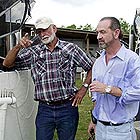Importer bets on farmed caviar
Category : Food Stories, Party Ideas, Recipes, Press Room |
Posted : Aug 11, 2003
Posted August 11, 2003
PIERSON -- Mark Zaslavsky reached into the large water tank and grabbed the gray, torpedo-shaped fish as it rose to the surface.
.gif)

 The fish, a 4-foot beluga sturgeon, flailed in Zaslavsky's arms, turning his effort to show off his vision into a soggy man-vs.-fish wrestling match.
The fish, a 4-foot beluga sturgeon, flailed in Zaslavsky's arms, turning his effort to show off his vision into a soggy man-vs.-fish wrestling match.
The fine-foods importer is willing to take a wet beating as he pursues his dream to be the first in the United States to farm-raise one of the world's rarest and most expensive delicacies -- beluga caviar.
Zaslavsky thinks that, if he succeeds, he could help reduce pressure on the central Asian freshwater fish that produces the treasured eggs -- and make money.
"About five years ago, when supplies of beluga got scarce, we decided to bring fish [to America] and grow our own fish," said Zaslavsky, president of Marky's Caviar of Miami. "It's our part to save the wild population in the Caspian Sea."
Twenty-five beluga sturgeon -- prehistoric creatures that can reach 1,800 pounds -- have been imported since the spring to an aquafarm in Pierson, 30 miles west of Daytona Beach, with another 25 on the way.
Other species are farmed across the nation, with California's white sturgeon industry a notable success story, but this is the inaugural American try at growing beluga's pearls commercially.
"We are the trailblazers here," said Frank Chapman, a University of Florida associate professor of fisheries and aquatic sciences providing technical expertise to Zaslavsky.
Farming beluga taxes the patience, as the females need up to 30 years to reach egg-laying maturity. Zaslavsky and partner Gene Evans, owner of the aquafarm in western Volusia County, won't know for at least two years if they've succeeded, judging by whether they can artificially fertilize eggs and hatch babies.
"I think, at that point," Evans said, "you're going to say we're in the sturgeon business."
The first shipment of beluga cost Zaslavsky $4,000, plus years of frustration while working his caviar contacts and cutting through red tape in Russia and the United States. Until those fish arrived in Miami for shipment to Evans' 2,700-acre farm near Pierson, there were only two belugas in America -- and they were in aquariums, Chapman said.
It could be as late as 2010 before the farm can deliver caviar. But there would be a payoff at the end of the wait, as that roe currently retails for upward of $35 per ounce. Fresh sturgeon meat could be ready for sale a few years earlier, and it sells for $14 to $15 per pound wholesale, with the smoked product reaching $22 per pound.
Also swimming in Evans' tanks are two other species of sturgeon: sevruga and osetra. Those fish produce less-coveted caviar.
"With nature and the economy, it's a risky business," Evans said. "Is it impossible? By no means."
The 63-year-old's drawl and ranch-hand looks strike a sharp contrast to Zaslavsky, a 50-year-old Ukrainian immigrant with a deep accent and ponytail. The two met through Chapman's aquaculture program.
One potential obstacle already threatens to cut short the partners' caviar dreams. Sturgeon stocks in the Caspian are thought to be in such low numbers -- down 90 percent over the last 20 years, according to one study -- that the U.S. government is considering listing beluga sturgeon as endangered. Such a decision by the U.S. Fish and Wildlife Service would effectively kill sales of beluga caviar in America.
Wild beluga sturgeon are found mostly in the Caspian, an enormous lake of cold, salty water that borders Russia, three former Soviet republics and Iran. Caviar has been harvested here since the days of Aristotle, but pollution, loss of spawning habitats and overfishing has taken a heavy toll.
The health of the sturgeon stocks is such a contentious issue between environmentalists and the caviar industry that even basic facts are in dispute. According to conservation groups, the caviar trade from the Caspian is estimated to be worth $100 million a year -- but Zaslavsky said that number is inflated tenfold.
Ironically, it could be an animal native to Florida that could save the beluga industry from a premature death. In 1987, alligators were struck from the list of endangered species after 20 years because farms helped restore the population.
"There is a precedent with the way alligators were handled years ago," said Marie Maltese, a biologist with the wildlife service. "So, exemptions for aquaculture are a possibility that could be considered."
The wildlife service is expected to rule on the status of beluga sturgeons by Jan. 31.















